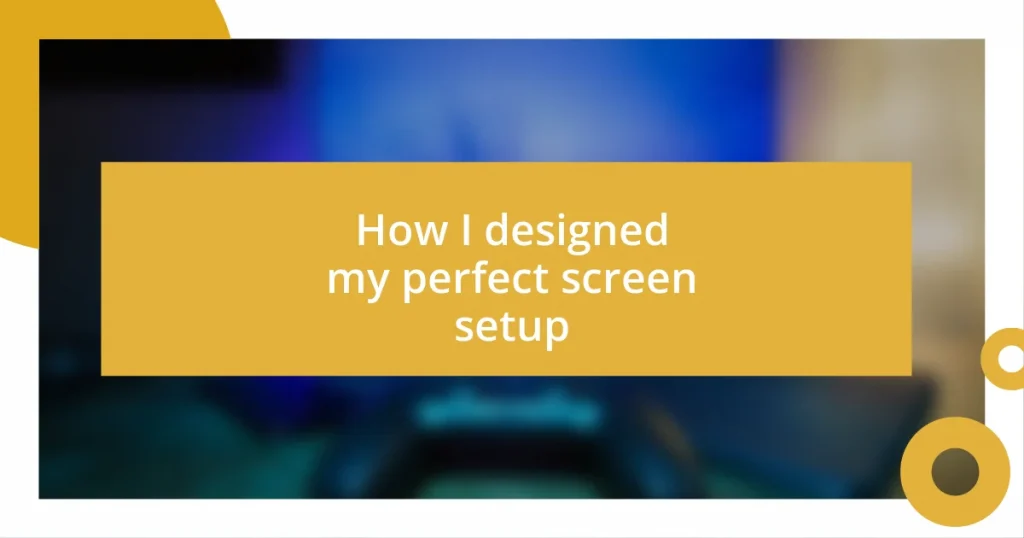Key takeaways:
- Choosing the right screen size and resolution can significantly enhance productivity and comfort, with personal preference and workspace limitations playing crucial roles.
- Different panel types (IPS, TN, VA) cater to varying needs in color accuracy, response times, and contrast, influencing overall viewing experience.
- Proper cable management, adjustable screen height, and thoughtful lighting can transform a workspace into a more organized and inspiring environment.

Choosing the right screen size
When I first upgraded to a larger monitor, it felt like a game changer. It’s like stepping from a cozy little café into a bustling library—suddenly, there’s so much more room to breathe and focus on multiple tasks. Have you ever found yourself squinting at tiny text on a screen? That’s a clear sign it might be time for a size adjustment.
I remember the struggle of balancing screen size with desk space; I wanted the expansive feel of a large display but was limited by my workspace. After diving into options, I opted for a 27-inch screen. For me, it struck the perfect balance—providing ample viewing real estate without feeling overwhelming. How does your workspace dictate your choice?
Ultimately, screen size isn’t just about dimensions; it’s about how it affects your productivity and comfort. A too-small screen can lead to eye strain and frustration, while a giant setup might feel daunting in a small room. Have you weighed up the pros and cons of what works best for your unique needs? Design your setup so that it feels just right for you!

Determining optimal screen resolution
Determining the optimal screen resolution is crucial for a comfortable and efficient viewing experience. I still remember the moment I switched from 1080p to 1440p resolution; the difference was striking. As I admired the crisp images and sharper text, I felt like I’d unwrapped a gift instead of just making a technical upgrade. It made my work and leisure activities feel much more immersive.
To find the right resolution for your setup, consider these factors:
– Screen Size: Larger screens often benefit from higher resolutions to maintain quality.
– Viewing Distance: The closer you sit, the higher the resolution you’ll want to avoid pixelation.
– Task Requirements: Design work or gaming might demand higher resolutions for detail.
– Graphics Card Capability: Ensure your hardware can support your desired resolution for optimal performance.
– Personal Preference: Ultimately, it’s about what feels good for your eyes and your workflow.
It’s fascinating how a higher resolution can alleviate strain and enhance productivity. I’ve found that the more I invest time in calibrating my display to personal preferences, the more enjoyable my screen time becomes.

Selecting the best panel type
Choosing the best panel type is key to creating the ideal screen setup. In my experience, the differences between IPS, TN, and VA panels can be quite dramatic. I recall my first IPS monitor—initially, I was drawn in by the vibrant colors and wide viewing angles. The moment I sat down to watch a movie, it hit me: it was like trading in an ordinary painting for a masterwork. The immersive experience was undeniable, and it made me appreciate the importance of color accuracy in design work.
When I switched to a TN panel for a gaming monitor, I was astounded by the rapid response times, but I quickly missed the richness of color I’d enjoyed with the IPS. It’s a classic trade-off; for gamers seeking performance, TN panels offer speed but at the cost of color quality. VA panels, on the other hand, served me well for deep blacks and contrast, which enhanced my movie nights. Balancing these features against my needs took some trial and error, but ultimately, I understood what resonated with my visual preferences and usage requirements.
Ultimately, selecting the right panel type isn’t just a technical decision; it’s about aligning with your personal experience and comfort. Have you considered how each panel technology could influence your daily tasks? In reflecting on this, I realized that a great screen doesn’t just serve a purpose—it’s a partnership between technology and the way we interact with it every day.
| Panel Type | Pros | Cons |
|---|---|---|
| IPS | Excellent color accuracy, wide viewing angles | Higher response times, can be more expensive |
| TN | Fast response times, usually cheaper | Poor color reproduction and viewing angles |
| VA | Great contrast, deep blacks | Slower response times, can be pricier than TN |

Adjusting screen height and angle
Finding that sweet spot for screen height and angle has been a game-changer for my setup. Initially, I had my monitor placed too low, and I often felt strain in my neck after long hours. Once I elevated the screen to eye level, it was like a light bulb went off; my posture improved, and the discomfort faded almost immediately. Have you ever noticed how the little adjustments make a world of difference?
When it comes to angle, I’ve learned that tilting your screen slightly back helps reduce glare and improves visibility. I remember fiddling around with different angles, feeling a bit like a scientist in my own workspace. Just a few degrees can change how light hits the screen and, consequently, how comfortable your eyes feel. I’ve found that a 20 to 30-degree tilt often works wonders, especially during those marathon work sessions.
Another aspect that surprised me was the importance of adjustable arms for my monitors. Investing in a good mount allowed me to change the height and angle on the fly. I can’t tell you how freeing it felt to customize my screen position while switching between tasks—simply sublime! What about you? Have you played around with alternatives to fixed stands? It can truly make a difference in your overall experience.

Managing cable organization
Managing cable organization can feel daunting, but it’s essential for achieving that perfect screen setup I’ve always envisioned. I started out with a tangled mess of cables, and I was almost embarrassed to showcase my workspace to friends. However, when I invested in cable management solutions like under-desk trays and velcro straps, it was like a breath of fresh air. Have you ever experienced the relief that comes from a clean workspace? I certainly have!
One thing I discovered is the value of labeling cables. At first, I thought it was a bit excessive, but when I upgraded my gear, it became a lifesaver. I vividly recall the day I had to troubleshoot my setup—having clear labels helped me identify which cable went where without fiddling for ages. It transformed what could have been a frustrating mess into a simple task. What little changes could you make to streamline your setup?
Additionally, I found that keeping cables of similar lengths really makes a difference. When I was experimenting with cable lengths, I realized that shorter cables not only look nicer but also reduce clutter. It’s almost like tidying your home; if things have a place, your workspace feels less chaotic. I even switched to cable sleeves for a cohesive look, and suddenly my desk transformed from cluttered to sleek. Isn’t it incredible how these small adjustments can significantly impact your daily productivity and your overall mood?

Enhancing workspace lighting options
When I began enhancing my workspace lighting, I realized that the right ambiance can entirely shift my mood and productivity. Initially, I relied solely on overhead lights, which cast harsh shadows and made my eyes tired after a while. Once I introduced a warm desk lamp with adjustable brightness, it was as if I had transformed my workspace into a cozy haven. Have you ever noticed how lighting can affect your energy levels? For me, it truly makes all the difference, especially during long hours.
Moreover, I learned the value of layering different light sources. By combining task lighting with ambient lighting, I’ve created a more dynamic feel in my workspace. I remember the first time I switched on my accent lights while working late; the soft glow not only illuminated my desk but also created a sense of calm. It felt less like a boring office and more like a creative studio. Have you considered adding multiple light sources to your setup? It’s a simple way to enhance the overall atmosphere.
Finally, I can’t stress enough the importance of color temperature. I was a bit skeptical about this at first, but using bulbs with a color temperature around 4000K has been a game-changer. This balance between warm and cool light helps to keep me alert without feeling too harsh. I distinctly remember the feeling of fatigue lifting as I embraced this adjustment, allowing me to focus better on my tasks. What lighting adjustments could you explore to elevate your workspace? Believe me, making these tweaks can lead to newfound energy and inspiration in your daily routine.















